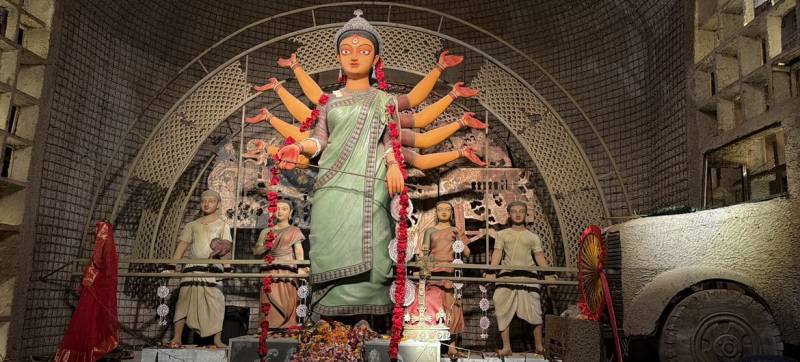- UNRWA Situation Report on Crisis in Gaza & Occupied West Bank |
- Intimidation or bloodshed cannot halt Bangladesh’s march to democracy |
- Khaleda Zia integral to an important chapter in BD history: Yunus |
- Enthusiasm marks Victory Day celebrations across Bangladesh |
- Dhaka-Delhi ties deep; to be shaped by trust, dignity, mutual respect |
Durga Puja Turns Kolkata Into a Living Art Festival

A Durga Puja pandal on the theme of riots, urges peace and harmonious community life.
India’s eastern state of Bengal transformed this week into the world’s largest public art festival — an immersive blend of worship, artistic expression, and social messaging — thanks to the annual Hindu festival known as Durga Puja.
Inscribed by UNESCO in 2021 as an element of the Intangible Cultural Heritage of Humanity, Durga Puja is more than a festival. It is a city-wide act of reimagination that resonates with the Bengali diaspora and communities across the globe.
For a few autumn nights, Kolkata and other parts of West Bengal became open-air galleries. Local communities built dazzling temporary temples or pandals, artisans from Kumartuli sculpted the goddess from river clay, drummers (dhaakis) filled the streets with rhythm, and millions wandered through illuminated dreamscapes.
The festivities drew to a close on Thursday.
What appears as spectacle is actually a community in motion: local clubs raising funds, families volunteering, craftspeople collaborating, and entire economies springing to life around food, lights, music, and art. Families planned their “pandal-hopping” routes, musicians set the rhythm, food stalls bound the city together, and Kolkata itself became a stage where class, caste, and ethnic divisions melted away.
UNESCO Recognition
UNESCO recognised Durga Puja, named after the Hindu goddess Durga, in 2021, describing it as “the best instance of the public performance of religion and art, and a thriving ground for collaborative artists and designers.”
Tim Curtis, UNESCO Representative in India, explained: “It embodies the Sarbojonin spirit — ‘for all people’ — that has defined community worship since 1926. From clay sculptors to drummers, designers to local organisers, the entire city contributes to one of the most vibrant cultural expressions in the world.”
This is heritage not locked away in monuments but alive in practice, passed hand-to-hand through craftsmanship, reimagined each year with new themes, and binding communities across class, faith, and language.
Durga Puja is also a creative economy powerhouse. A 2019 study estimated that festival-related industries generate $4.53 billion, amounting to 2.58 per cent of West Bengal’s GDP.
Art with a Message
For Shombi Sharp, United Nations Resident Coordinator in India, this year marked his first visit to a century-old pandal spotlighting sustainable agriculture, emphasising the broader importance of the Sustainable Development Goals.
“Normally you see Goddess Durga defeating evil — here the ‘evil’ is pesticides and unsustainable farming practices. Behind me stands a display of 280 rice varieties from eastern and northeastern India. That’s 12 to 13 million visitors being exposed to powerful messages about organic agriculture, biodiversity, and sustainability,” he said.
Another headline-grabber was an AI-themed pandal fusing devotion with digital imagination. Goddess Durga appeared in her traditional form — ten arms and a lion — set against circuit-board patterns, glowing data streams, and neon light. The message was clear: faith and technology can coexist, even in a futuristic frame.
Visitor reactions reflected both wonder and caution. “The more positively people receive AI, the better,” said 30-year-old lab technician Nupur Hajara from Kolkata. “If they take it negatively, that won’t help — right?”
IT professional Sumitam Shom added: “Durga Puja is our biggest, most special festival — and now AI is part of the conversation. It can do a lot of good, but there are risks too, especially fraud. Deepfakes and viral images are real concerns. Without safeguards, someone could misuse photos and deceive people. So it’s crucial we use these technologies responsibly.”
Adding urgency, a pandal themed “Shabdo” (“Sound”) drew attention to the vanishing sounds of nature — chirping birds, rustling leaves, croaking frogs — through immersive sensory design.
“It was a meditation on environmental loss and nostalgia,” said Raja, a visitor. “You barely see birds anymore. My grandfather told me how common they were. Now they’re rare — partly, we believe, because of mobile networks. This pandal is our way to wake up the community, to learn how to bring the birds back, and to start working on it together.”
Other pandals echoed urgent social themes, including one honouring acid attack survivors, not only raising awareness but celebrating their dignity and contributions, while another highlighted water conservation.
For young visitors, the messages resonated. Tisa, an 18-year-old student at a pandal dedicated to water conservation, reflected: “Groundwater is depleting day by day. This is the best way to spread awareness to the public.”
Making Puja Accessible to All
Durga Puja is also moving toward inclusivity.
In June 2025, UNESCO and the UN in India, working with organisations of persons with disabilities, launched comprehensive accessibility guidelines for festival organisers.The results were visible on the ground.
Ramps and barrier-free layouts eased mobility, Braille signage and sign-language interpreters expanded communication, and quiet seating areas allowed visitors to rest.
As Shombi Sharp recalled, “We heard from a father who, for the first time in 17 years, was able to bring his daughter, a wheelchair user, to celebrate Durga Puja. That was an incredibly emotional moment.”

